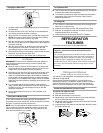
20
To Clean Your Refrigerator:
NOTE: Do not use abrasive or harsh cleaners such as window
sprays, scouring cleansers, flammable fluids, muriatic acid,
cleaning waxes, concentrated detergents, bleaches or cleansers
containing petroleum products on exterior surfaces (doors and
cabinet), plastic parts, interior and door liners or gaskets. Do not
use paper towels, scouring pads, or other harsh cleaning tools.
1. Unplug refrigerator or disconnect power.
2. Hand wash, rinse, and dry removable parts and interior
surfaces thoroughly. Use a clean sponge or soft cloth and a
mild detergent in warm water.
3. Clean the exterior surfaces.
Painted metal: Wash painted metal exteriors with a clean,
soft cloth or sponge and a mild detergent in warm water.
Rinse surfaces with clean, warm water and dry immediately to
avoid water spots.
Stainless steel: Wash stainless steel surfaces with a clean,
soft cloth or sponge and a mild detergent in warm water.
Rinse surfaces with clean, warm water and dry immediately to
avoid water spots.
NOTE: When cleaning stainless steel, always wipe in the
direction of the grain to avoid cross-grain scratching.
4. There is no need for routine condenser cleaning in normal
home operating environments. If the environment is
particularly greasy or dusty, or there is significant pet traffic in
the home, the condenser should be cleaned every 2 to
3 months to ensure maximum efficiency.
If you need to clean the condenser:
■ Remove the base grille.
■ Use a vacuum cleaner with a soft brush to clean the grille,
the open areas behind the grille and the front surface area
of the condenser.
■ Replace the base grille when finished.
5. Plug in refrigerator or reconnect power.
Changing the Light Bulbs
IMPORTANT:
■ Not all appliance bulbs will fit your refrigerator. Be sure to
replace the bulb with an appliance bulb of the same size,
shape, and wattage.
■ To ensure optimum refrigerator performance, replace light
bulbs as soon as they burn out.
Refrigerator Compartment Light
The light bulbs are located at the top of the refrigerator
compartment.
1. Unplug refrigerator or disconnect power.
2. Using both hands, squeeze inward on the sides of the light
shield, releasing it from the back of the compartment. Then,
move the shield toward the back to release it from the front of
the compartment.
3. Remove the light bulb(s) and replace it with a 40 watt
appliance bulb of the same size and shape.
4. Replace the light shield by inserting the front end into the
compartment and then pushing up until it snaps into place.
5. Plug in refrigerator or reconnect power.
Freezer Compartment Light (on some models)
1. Unplug the refrigerator or disconnect power.
2. Remove the light shield (on some models).
■ Top of the freezer compartment - Slide the light shield
toward the back of the compartment to release it from the
light assembly.
3. Replace the burned-out bulb with an appliance bulb(s) no
greater than 25 watts.
4. Replace the light shield.
5. Plug in refrigerator or reconnect power.
Vacation and Moving Care
Vacations
If You Choose to Leave the Refrigerator On While You’re
Away:
1. Use up any perishables and freeze other items.
2. If your refrigerator has an automatic ice maker, and is
connected to the household water supply, turn off the water
supply to the refrigerator. Property damage can occur if the
water supply is not turned off.
3. If you have an automatic ice maker, turn off the ice maker.
NOTE: Depending on your model, raise the wire shutoff arm to
OFF (up) position, or press the switch to OFF.
4. Empty the ice bin.
If You Choose to Turn Off the Refrigerator Before You
Leave:
1. Remove all food from the refrigerator.
2. If your refrigerator has an automatic ice maker:
■ Turn off the water supply to the ice maker at least one day
ahead of time.
■ When the last load of ice drops, raise the wire shutoff arm
to the OFF (up) position or press the switch to OFF,
depending on your model.
3. Turn off the Temperature control(s). See “Using the Control(s).”
4. Clean refrigerator, wipe it, and dry well.
5. Tape rubber or wood blocks to the tops of both doors to prop
them open far enough for air to get in. This stops odor and
mold from building up.


















